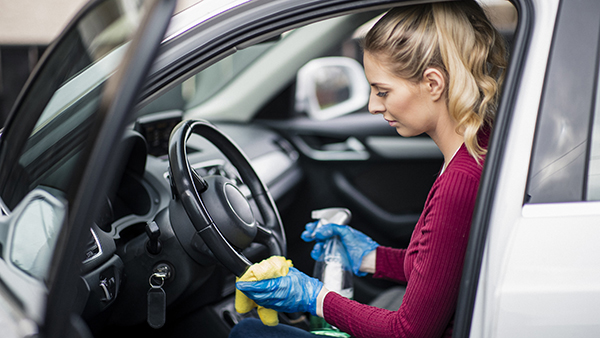By now, most of us know that frequently washing our hands is one of the best ways to avoid contracting COVID-19. But what happens if the virus is transmitted to other surfaces before you get the chance to wash your hands? This is especially likely when you perform essential tasks like grocery shopping or filling up your gas tank. These tasks require you to touch objects that have been previously handled by other people, including produce and the gas pump.
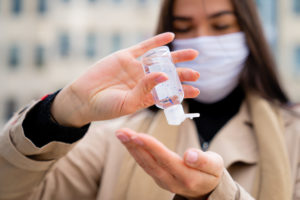 So, what do you do if there’s no opportunity to wash your hands before you get back into your car? The only thing between you and the grocery store is the parking lot, after all. If possible, use a hand sanitizer with at least 60% ethanol and 70% isopropanol before touching your car’s door handle. If you can’t find adequate hand sanitizer anywhere, you should consider thoroughly sanitizing your vehicle when you get home. Until then, try to avoid touching your face until you can wash your hands. Additionally, minimize the surfaces you touch where possible.
So, what do you do if there’s no opportunity to wash your hands before you get back into your car? The only thing between you and the grocery store is the parking lot, after all. If possible, use a hand sanitizer with at least 60% ethanol and 70% isopropanol before touching your car’s door handle. If you can’t find adequate hand sanitizer anywhere, you should consider thoroughly sanitizing your vehicle when you get home. Until then, try to avoid touching your face until you can wash your hands. Additionally, minimize the surfaces you touch where possible.
How to Sanitize Your Car Safely
Since vehicle interiors are typically small, confined spaces, germs can spread quickly. That’s why it’s best to give everything a good cleaning even if you only touched your steering wheel and seatbelt. However, make sure that you don’t use chemicals that can damage the interior surfaces of your car.
Check out our tips on the best car sanitizing practices when it comes to coronavirus.
Focus on High-Touch Areas
First, you’ll want to pay attention to any high-touch areas in your car. Common high-touch surfaces include:
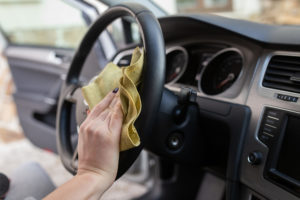 Steering wheel
Steering wheel- Door handles
- Shift lever
- Seatbelts and buckles
- Window buttons
- Armrests
- Touchscreens
If you’re a taxi or rideshare driver, then you may have more high-touch areas in your vehicle that need to be sanitized more frequently, ideally after each passenger. Remember to clean both the outside door handles and the inside ones, too.
Use the Right Alcohol Solutions
 The materials that make up the interior of your car are less durable than surfaces like a kitchen counter or a bathtub. However, there are still some household cleaning products you can use to sanitize the interior.
The materials that make up the interior of your car are less durable than surfaces like a kitchen counter or a bathtub. However, there are still some household cleaning products you can use to sanitize the interior.
According to the CDC, alcohol solutions that contain at least 70% alcohol are effective against coronavirus. One type of solution to use on your car’s interior is isopropyl alcohol. You can find isopropyl alcohol at your local drugstore or online. Just make sure to read the label to ensure you’re buying the right alcohol level.
Use Disinfectant Wipes or Soap
If you don’t have isopropyl alcohol at home, don’t want to go into the store to buy it, or don’t want to wait for it to be shipped, then you can use disinfectant wipes or soap and water. Keep in mind that not all disinfectant wipes are effective against coronavirus. Following the guidelines of the Environmental Protection Agency (EPA), Clorox Disinfecting Wipes and Purell Professional Surface Disinfectant Wipes are suitable options.
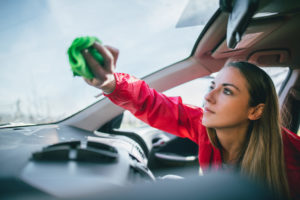 Soap and water are safe to use on most car interiors, but it’s important to avoid scrubbing too hard. You want to use enough friction to be effective against germs, but also gentle enough that you don’t damage the seat upholstery or dashboard surface.
Soap and water are safe to use on most car interiors, but it’s important to avoid scrubbing too hard. You want to use enough friction to be effective against germs, but also gentle enough that you don’t damage the seat upholstery or dashboard surface.
Additionally, try to avoid creating too many suds as they can be difficult to get rid of once they’ve formed. This is especially true if your car has fabric upholstery. Avoid using too much water, as well. You don’t want liquids soaking through the seat fabric and into the cushions beneath. This can cause a musty smell or even mold growth.
What Not to Use
It’s advised to avoid using any type of bleach or hydrogen peroxide to sanitize a car’s interior. Both chemicals are effective against coronavirus, but they’re also likely to damage the fabrics or plastics in your vehicle.
Additionally, you should avoid using any ammonia-based products because ammonia breaks down the vinyl on the dashboard. It can also damage the anti-glare and anti-fingerprint coatings on car touchscreens.
How to Prevent Damage or Discoloration
As previously mentioned, it’s safe to sanitize a vehicle’s interior with alcohol, including most car leathers and imitation leathers. However, cleaning leather with alcohol can leave it susceptible to damage or discoloration over time. Do your best to avoid this by spot cleaning with soap and water, as well as investing in a good leather cleaner and leather conditioner.
Remember to Wash Your Hands
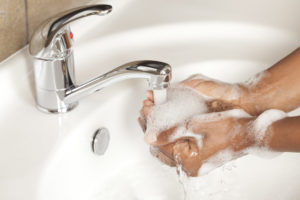 Yes, we’re repeating it: Wash your hands! This is the easiest way to avoid the spread of COVID-19. It’s important to remember to always wash your hands after sanitizing your car so that you do not accidentally re-contaminate an already clean surface.
Yes, we’re repeating it: Wash your hands! This is the easiest way to avoid the spread of COVID-19. It’s important to remember to always wash your hands after sanitizing your car so that you do not accidentally re-contaminate an already clean surface.
Washing your hands and keeping your distance from others when you must go outside your home for essential items is important during this time. Sanitizing your car and any other surfaces that may have come into contact with COVID-19 is an additional step you can take to help stop the spread. Do your part to protect the health of yourself and others.
The information in this article is obtained from various sources. This content is offered for educational purposes only. It should not replace the advice of a qualified organization or professional. No warranty or appropriateness for a specific purpose is expressed or implied.
